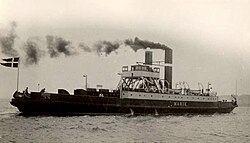Marie (ship, 1890)
|
Steam ferry Marie
|
||||||||||||||||||||
|
||||||||||||||||||||
|
||||||||||||||||||||
|
||||||||||||||||||||
|
||||||||||||||||||||
|
||||||||||||||||||||
The Marie was a single-track Danish steam train ferry and was designed by DSB at Burmeister & Wain ordered. She was delivered with the construction number 157 on April 16, 1890.
Calls
The railway ferry was built for the Fredericia – Strib ferry route across the Little Belt on the København – Fredericia railway line . There she supported the steam ferry Valdemar from 1890 . The Marie was equipped as an icebreaker.
The ferry connection across the Little Belt was given up with the commissioning of Lillebæltsbroen on May 14, 1935.
As early as 1905 the ferry was moved to Masnedø in order to provide the ferry service there over the Storstrømmen on the Ringsted – Rødby Færge railway to Orehoved . As part of this relocation, the ferry's home port was also relocated to Masnedø on August 26, 1914.
The ferry route across Storstrømmen was closed on September 26, 1937 with the inauguration of Storstrømsbroen .
The ferry stayed here only for a few years before being used on the Glyngøre - Nykøbing Mors ferry route from 1916 . Masnedø remained the home port. She drove on this route until the end of her mission.
On Mors , the Railway Act of May 27, 1908 planned two railway lines on the island with the starting point in Nykøbing. The ferry port with siding in Nykøbing was the only measure that was carried out according to these plans.
Conversions
From 1904 to November 2, 1905, the ferry was rebuilt and extended in the Kjøbenhavns Flydedok og Skibsværft shipyard . On this occasion, the ship received another steam engine for a propeller attached to the front.
On June 11, 1935, the Marie received a narrow-gauge track to bring new vehicles to Rønne for De Bornholmske Jernbaner (DBJ) on the island of Bornholm . DBJ drove with meter gauge vehicles.
Special transports
The Marie with Captain I. Schmidt from Fredericia played an important role in the commissioning of the Langelandsbane , as this ship carried most of the rail vehicles there.
On May 26, 1911, the ship came from Orehoved, loaded with the three LB 1-3 locomotives and four gondolas . These had been built by Henschel in Kassel . The locomotives alone were worth around 70,000 crowns .
The next day the first passenger cars, five 3rd class cars, were brought to the island by ship. The cars were built at Scandia in Randers . They were equipped with electrical lighting and an accumulator for buffering. One of the cars had a mail compartment. For this purpose, two more freight cars were brought to Langeland.
The delivery of three bench wagons ( Danish: Bænkevogne ) from Arlöfs Mekaniska Verkstad & Waggonfabrik (freight wagons that could be equipped with benches for the transport of people), plus two baggage wagons, also from Arlöf, is noted for May 28th.
More cars were delivered one day later, so that five 3rd class cars, one 2nd class car, three combined 2nd / 3rd class cars. 1st class car and two combined passenger / post cars from Scandia were available. All cars were designed as through cars, the 3rd class and 2nd class cars had the aisle in the middle with seats on the sides. The combined cars had a side aisle, the toilet was between the two classes of car. All vehicles were equipped with a vacuum emergency brake.
On July 5, the ferry brought the LB M 1 railcar and other bench cars .
accident
In an accident on July 7, 1935, the Marie drove to the quay wall in difficult conditions in the port of Thyborøn . There were 320 passengers on board, 17 were slightly injured. After this accident, the ferry was no longer repaired.
Sale and scrapping
On December 30, 1935, the ship was sold to the scrap company Petersen & Albeck in Copenhagen. It was scrapped there in 1936.
